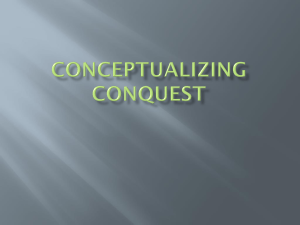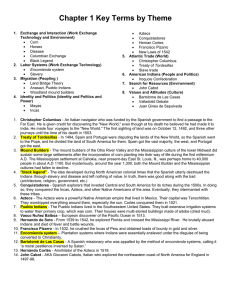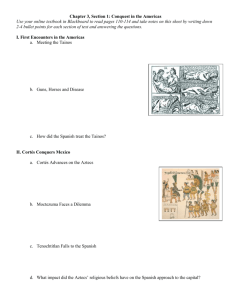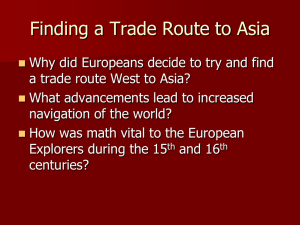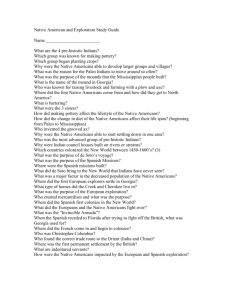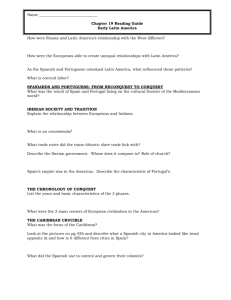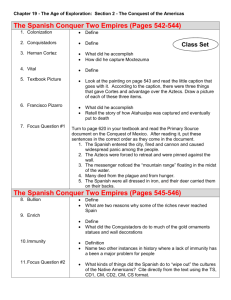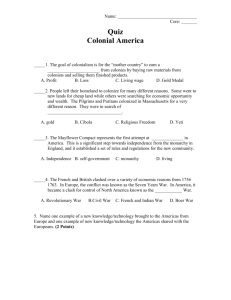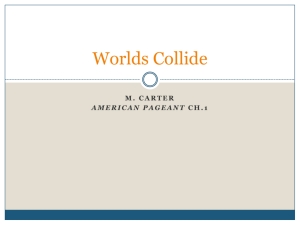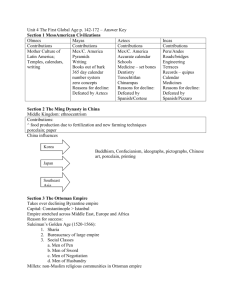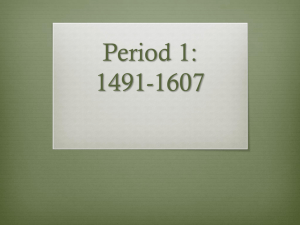Lecture 5, July 15
advertisement
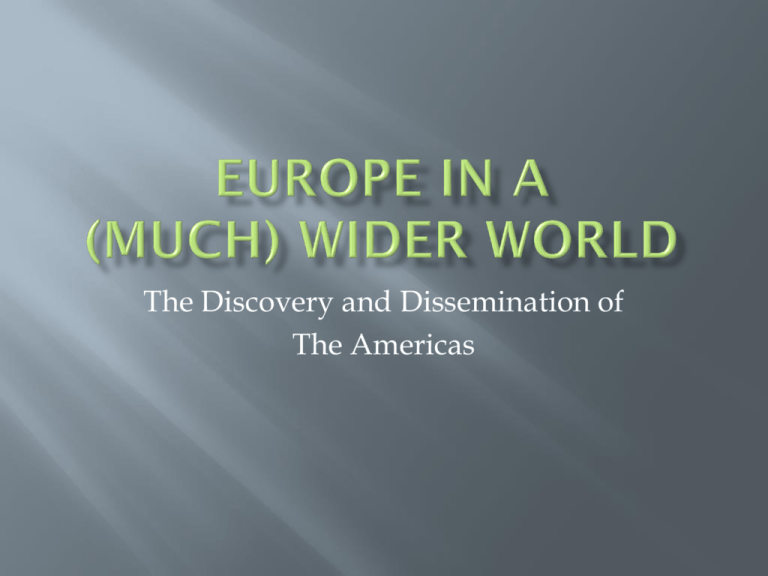
The Discovery and Dissemination of The Americas The first colonies: the Atlantic Islands as staging ground The Horn of Africa: source of gold and slaves Tapping into existing networks of exchange A “trading post” empire: response to extant local powers The caravel as essential technological advance The caravel combined square and triangular sails, and could be sailed by a small crew in rough waters. It was an adaptation of existing ship forms, and was a dominant design for three centuries Besides the ship, four key technologies aided exploration: Compass, astrolabe, portolanos, and gunpowder Jose de Aguiar, Portolan Chart of 1492 showing coast lines and rhumb lines Vasco da Gama (1497- 99): Rounded Cape of Good Hope and reached India China as major power: unconcerned with expansion Trade in luxury goods – for bullion or manufactured materials Advanced local cultures, with limited European impact Portugal’s “factory system” The exportation of Christianity Ferdinand of Aragon and Isabella of Castile: the parents of Spain in 1469 Creating a Christian country: Inquisition and episcopal support 1492: The conquest of Granada, expulsion of the Jews, and sending of Columbus Born in Genoa, he was 41 when he reached the Caribbean Desired to reach both the Far East and Holy Land by circling around the Ottomans First turned to Portuguese crown, but was turned down for his prophetic and biblical approach to geography Drastically underestimated circumference of the globe, but accidentally reached the Americas Four voyages: 1492, 1493, 1498, and 1502 Always believed that he had reached India Initially sailed with three ships and only ninety men A great explorer, but a terrible administrator: arrested after stint as governor of Hispaniola in 1500 The diffusion of new commodities: chocolate, tobacco, tomatoes, etc… The display of new world natives: living ethnography The quest for continued patronage and the granting of royal privileges The diffusion of new knowledge Pictorial – woodcuts and art Literary – through the new vehicle of print Oral – the stories sailors share The Role of the Popes Eximiae Devotionis (May, 1493) – Papal sovereignty over the Americas? Dudum Siquidem (Sept., 1493) – The Division of the New World Treaty of Tordesillas (June 1494) – Political settlement of spheres of influence The Role of the Spanish Junta (1504) – Consultation and confirmation Requerimiento (1513) – Legal declaration of Spanish rites read to an unknowing audience The role of conquistadores: the quest for lands and royal income drove the integration of American lands into the Spanish empire The need for the “royal fifth” Sham offers of peace: the requerimiento and an expansive definition of just war The encomienda system: agricultural production, religious education, and the formation of a landed Spanish elite The limits of assimilation: syncretic religion and the creation of a hybrid, mestizo culture 1: The Indians are to be removed from their land and placed into encomiendas 3: The citizen to whom the Indians are given must erect a structure to be used as a church. 4: To make sure the Indians are learning Christianity properly, they shall be tested every two weeks and taught what they do not know by the Encomendero. 14: The Indians must be allowed to perform their sacred dances. 23: Official inspectors must keep records of the activities and also the treatment of the Indians in the encomiendas. 24: The Indians are not to be physically or verbally abused for any reason. Aztecs: the flowery war, a militarized society, and the problem of human sacrifice Incas: intense centralization, infrastructure, and a disastrous dynastic war Parallels to Ancient Sumeria: Irrigation and agriculture City States and Patron Gods Intensive regional trade Stratification: Noble vs. commoner Unrelenting focus on hierarchy and status Highly militarized, and engaged in perpetual, “flowery war” The goal: providing sacrifices for religious ritual The construction of a central haven: Tenochtitlan as the center of empire The contrast of refinement and savagery Arriving in Mexico in 1519, Hernán Cortés set out to conquer the Aztecs. Despite having only 450 Spanish troops (and 15 horses), Cortés used native alliances and the Aztecs’ belief that he might be a god to strike decisively at Tenochtitlan. The Aztecs were totally defeated by 1522. Expansive and multi-ethnic: aggressively imperialistic in the 15th century Infrastructure and administration: intensive tax gathering and local governance Ecologically adaptive: terracing and corvee labor for roads and agriculture Too centralized? Pyramidal social structure could lead to total dependence on ruler A weakened empire: smallpox and a dynastic civil war Francisco Pizarro and the kidnapping of Atahuallpa (1531) The failure of ransom: only whet the Spaniards’ appetite for more 1533: Pizarro executes the emperor and seizes the capital of Cuzco All about silver, not gold Potosí as the real El Dorado A transition from optimism to skepticism The need to adjust to the imperatives of empire A shift in exploitative strategies From easy money to agricultural development Developing infrastructure for large scale extraction The difficulty of coming to grips with human diversity State and Church at cross purposes? The calculus of souls vs. the calculus of economic growth
